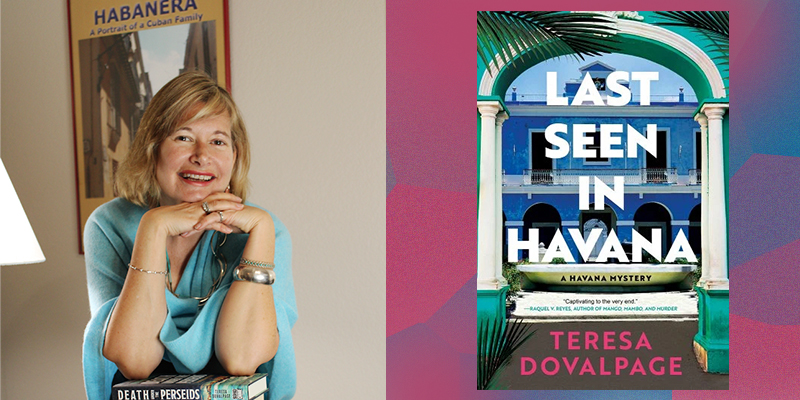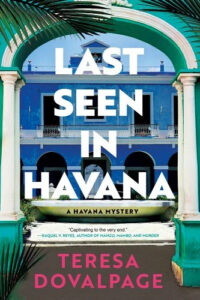Last Seen in Havana, a suspenseful addition to Teresa Dovalpage’s Havana Mystery series, was released by Soho Press in February 2024. The novel, which takes place in Havana poignantly captures the perspectives and experiences of Sarah Lee Nelson, a young woman from San Diego who remains in Cuba in 1986, after falling in love with a Cuban man, and Mercedes Spivey, a Cuban-born professional baker, who returns to Havana from the U.S. in 2019 to help the ailing grandmother who raised her. In alternating chapters, Last Seen in Havana leaps from the mid-1980s to a time that just precedes the pandemic in unspooling a powerfully moving mystery, one that will stay with readers long after the last page has been turned.
I have had the great good fortune of knowing Teresa Dovalpage for more than twenty years, as a friend and a fan of her books. I’m thrilled to have the chance to discuss with her this latest addition to her estimable oeuvre.
Lorraine Lopez: In Last Seen in Havana, you present dual narratives from two main characters, capturing the first-person perspective of Mercedes and the third-person limited POV of Sarah. How did you manage to braid both strands so well, transitioning from one character to the other in such a clear and seamless way? And what were some of the challenges you faced in telling the story this way?
Teresa Dovalpage: This was the first time I’ve tried a dual narrative so I am happy to know it reads fine. The idea of a novel about Mercedes’ search for her mother was in the back of my mind since I wrote Death under the Perseids. But I realized I needed more of a background story for it to be compelling. If readers didn’t know much about Mercedes’ mother, Sarah, why would they care about her? The biggest challenge was writing Sarah’s chapters. At first, they were letters she wrote to her friend Rob, but they sounded a bit off—I couldn’t get a young, surf-loving San Diegan’s voice right. So, I shifted to the third-person limited narrator and it worked much better.
LL: John Gardner calls compelling concrete details “proofs.” In presenting two time periods, you provide convincing temporal and place “proofs.” By what means—research, experience, memory—did you mine information for such significant detail?
TD: Getting the “proofs” was a walk down memory lane. I lived for my first thirty years in Cuba so it wasn’t hard to remember the details: the May First celebrations, the Russian presence (of course, in the 80s we called Russians “our Soviet comrades”), the diplotiendas (dollar stores), all that… But I also asked my mother and friends about the “good old bad old times,” and watched Cuban documentaries from those years, so I felt I was living in the 80s while writing the book. It was fun to go back in time in search of the “proofs!”
LL: In an essay in An Angle of Vision, wherein you describe cleaning an old and decrepit refrigerator, you mention determination to be apolitical in your writing. I believe you achieve this quite well, especially in this novel, where you observe circumstances without passing judgment on political contexts, allowing readers to draw their own conclusions. Why is this important to you as an author?
TD: I remember An Angle of Vision! So does my mother, who loves to remind me that I seldom cleaned the cabrón refrigerador. Anyway, growing up in Cuba, I had to read too many socialist realism novels. Thankfully, most of them are forgotten now! The sad part is that not all the authors were bad writers—I actually liked Manuel Cofiño’s work, without the politics. But the fact that politics were shoved down the readers’ throats made me hate its inclusion in my own work. Too much blablablá, political or otherwise, and readers will close the book and start playing with their phones.
LL: Friendship between women factors into the novel in an important way. Mercedes travels to Cuba supported by her friend Candela who accompanies her. Sarah forges connections with Dolores and Valentina, who offer her practical help and guidance. What is your view of these relationships? Do they enable the protagonists or provide genuine resources?
TD: I don’t know what I would do without my amigas! You are one of them! Friends provide so much needed support in life and literature…The reason why female friendships appear so often in my books is because they are part of my own experience. As a narrative resource, Candela gave me a chance to present Cuba as seen through American eyes—the questions she asks Mercedes are those that my American friends have about Cuba. The connections that Sarah forges with Dolores and Valentina are a way to showcase two ways of looking at the Cuban reality of the 80s: a Russian woman married to a Cuban man (which was quite common then), aware of the changes happening in Eastern Europe in the late 80s, and a committed Cuban revolutionary who has no idea of what was going on in the world at that time.
LL: In terms of characterization, Villa Santa Marta, the house where Mamina lives and where Mercedes grew up, emerges as an antagonist, one that poses physical threat to its occupants. At one point, Mercedes observes, “[T]he fact is, we lived in an angry house.” What was your idea behind casting Villa Santa Marta as a villain the novel?
TD: Places are fun characters to write about, more so when they are bad or scary, like Villa Santa Marta. I used to visit a house in Miramar, which I used as a model for the story, that had such a bad vibe that it gave me the creeps every time I went there. The fact that two people were killed in that house (in real life) reinforced the impression. I knew I would use it in a story someday.
LL: As an avid fan of the Havana Mystery Series, I’m eager to know what lies ahead for you. Can we expect another novel in the series? What are you working on now?
TD: In the book I am working now, Teresita is a woman in her fifties who lives in the US and writes mystery novels. Her journey as a writer started with an unsolved case she witnessed as a teenager: a teacher and a student who died in a suspected murder-suicide case at the middle school she attended. When her best friend is accused of committing that forty-year-old crime, Teresita goes back to Havana in an attempt to figure out what really happened on that April 1980 day. I loved turning myself into a character!
***


















